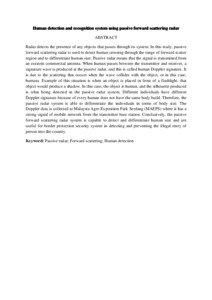Citation
Abdul Aziz, N. H. and Raja Abdullah, Raja Syamsul Azmir and Mohamed Yusof, A. N.
(2017)
Human detection and recognition system using passive forward scattering radar.
Science International, 29 (1 (spec.)).
pp. 69-73.
ISSN 1013-5316
Abstract
Radar detects the presence of any objects that passes through its system. In this study, passive forward scattering radar is used to detect human crossing through the range of forward scatter region and to differentiate human size. Passive radar means that the signal is transmitted from an existent commercial antenna. When human passes between the transmitter and receiver, a signature wave is produced at the passive radar, and this is called human Doppler signature. It is due to the scattering that occurs when the wave collides with the object, or in this case, humans. Example of this situation is when an object is placed in front of a flashlight, that object would produce a shadow. In this case, the object is human, and the silhouette produced is what being detected in the passive radar system. Different individuals have different Doppler signature because of every human does not have the same body build. Therefore, the passive radar system is able to differentiate the individuals in terms of body size. The Doppler data is collected at Malaysia Agro Exposition Park Serdang (MAEPS) where it has a strong signal of mobile network from the transmitter base station. Conclusively, the passive forward scattering radar system is capable to detect and differentiate human size and are useful for border protection security system in detecting and preventing the illegal entry of person into the country.
Download File
![[img]](http://psasir.upm.edu.my/62052/1.hassmallThumbnailVersion/Human%20detection%20and%20recognition%20system%20using%20passive%20forward%20scattering%20radar.pdf)  Preview |
|
Text
Human detection and recognition system using passive forward scattering radar.pdf
Download (5kB)
| Preview
|
|
Additional Metadata
Actions (login required)
 |
View Item |

